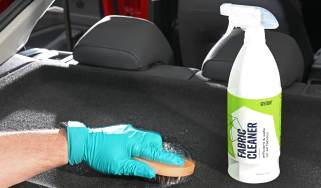Tyre care and maintenance : how to look after your car tyres
Maintain your tyres and you'll reap the benefits with an improved drive and lower running costs. We explain all
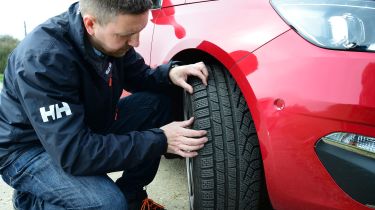
Tyres are an important part of your car, but their importance can often by overlooked. A wit once said they're designed to keep the wheels from scraping on the ground, but there's so much more to those round, black pieces of rubber. Looking after your tyres has a direct impact on how your car drives and, more importantly for some motorists, how much it costs to run your car.
If you think about it, car tyres have a lot of work to do. They support the weight of the vehicle (which moves from front-to-back and side-to-side while the car is in motion), provide grip in a wide range of weather conditions, are subjected to extreme forces in the event of emergencies and need to last a reasonable amount of time if they are to offer good value for money.
As an example, the average car exerts around 550kg of force if it's decelerating from 40mph to a standstill in five seconds – and all of that energy is channelled through the car’s tyres. Multiply the speed, reduce the braking distance and factor in the additional weight of vehicles like MPVs and popular SUVs, and these stresses and strains are amplified even further.
As a result, tyres are one of the most important purchases that a driver can make. Auto Express prides itself in producing the most comprehensive tyre tests in the UK, and the results we bring you demonstrate that buying the right set of rubber can improve a car's performance dramatically. But equally important is caring for tyres – although many people will simply bolt on the new rubber and forget about them until they get a puncture.
If you care for and maintain your tyres properly, then they will deliver the performance they're designed to throughout their useable life. And to help you get the best from them, Auto Express has compiled a list of tyre care tips and advice.
Tyre pressure
Air pressure has a natural tendency to escape from all tyres – this is due to changes in ambient temperatures and the construction of the tyre itself. Incorrectly inflated tyres can cause premature wear and tear, which will harm fuel economy and alter the car’s handling.
Keeping your tyres correctly inflated is one of the best things you can do to preserve their life and save on fuel. It’s advised to check tyre pressures every month and inflate them to your manufacturers recommendations – this can usually be found in the driver’s manual or on a pictogram located either in the fuel filler flap or on the door frame.
The best time to pump up your tyres is right before going for a drive, this is when they are coldest and the internal pressure the lowest. Filling your tyres after a long drive isn't such a good idea as driving generates heat in the surface of the tyre, which increases the internal pressure. To make up for the heat induced pressure, you'd need to add another four to five PSI (pounds per square inch) to the manufacturer's recommended figures.
Front and rear tyres sometimes come with different pressure requirements, so do double-check the required pressures - there will be recommended figures for both axles, while heavier loads or higher occupancy will often require higher pressures to maintain the tyre's performance.
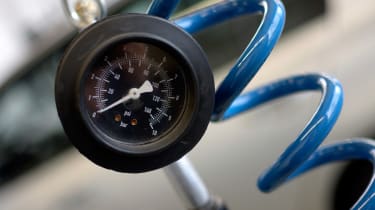
Tyre speed rating
All tyres come with a speed rating moulded on the sidewall. The rating is given by a set of numbers that indicates the load index (the maximum load a tyre can carry) and then a letter denoting the speed rating of each tyre.
A rating of 96V for example means a maximum load capacity of 710kg on each tyre at a maximum speed of 149mph. The higher the numbers and the letter in the alphabet, the higher the speed and load rating of the tyre.
The other numbers found on the sidewalls of your tyres are indicators of its tread width, height of the tyre wall and the rim size.
For example a 165/65 R14 79T tyre has a tread width of 165 millimetres, with the height of the tyre side wall equalling 65 per cent of the tyre width (the lower the number, the less rubber there is between the wheel rim and the road surface).
The 'R' stands for radial, which is the type of tyre construction, where steel and kevlar belts are bonded within the tyre so that the tyre maintains its shape and doesn't 'balloon' under the force of the wheel turning. This example tyre is 14 inches in diameter, so is intended to fit wheels of this size. Finally, the load and speed rating (79T) means the maximum weight the tyre can carry is 437kg and the top speed is 118 mph.
Tyre tread depth and wear
The minimum legal tread depth in the UK is 1.6mm. If you’re out of rulers, insert a 20p coin into the lowest tread depth and see if the outer edges of the rim cover the edge of the coin. If this is the case the tyre should still be legal.
While each illegal tyre can carry a fine up to £2,500 and serve you three penalty points, they are also a threat to safety. Tyres with low tread depth disperse water less effectively than a deeper tread and can extend your car's braking distance on wet roads.
It’s best to check your tyres for signs of cracks, wear and debris in the tread, as well as bulges in the sidewalls (which can signify a potential tyre failure) on a monthly basis to make sure they’re up to the task.
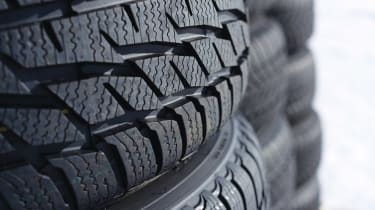
Alignment and balancing
Wheel alignment and tyre balancing is best left to the professionals with the right tools and expertise. When replacing a tyre, it’s always advised to get them balanced and realigned – this will prevent premature and rapid wear, as well as improve your handling.
Improper tyre balances or alignment can cause the car to shake at high speeds (which can be signified by the steering wheel vibrating in your hands) and upsets while cornering, too. If your car does this, a visit to the local garage or tyre shop is in order to get them re-balanced.
Storing tyres
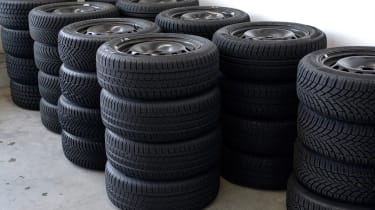
If you decide to swap between winter and summer tyres as the seasons change, pay attention to where you store your tyres. Even without use, tyres age and keeping them in certain places can hasten the process.
Keep your tyres stored in a well ventilated, dry and room-temperature area, away from sunlight and moisture so that the rubber compound remains in a good condition. Avoid stacking tyres on top of each other for long periods of time, and make sure the compound is kept away from chemicals and sharp objects.
Tyre products
Tyre shine not only adds a glossy effect to the sidewall, but also keeps the rubber supple and slows down the damaging effect of UV rays that cause cracking and premature failure.
Before applying a tyre sealant, make sure you know which sealants and chemicals your tyre manufacturer approves of. Auto Express has previously been contacted by readers who’ve applied the wrong chemicals to their tyres, causing cracks on the sidewalls.
It’s always best to contact your tyre manufacturer and ask them which products they would recommend.
Do you have any other tips for tyre care? Share them with us in the comments below…
Find a car with the experts




